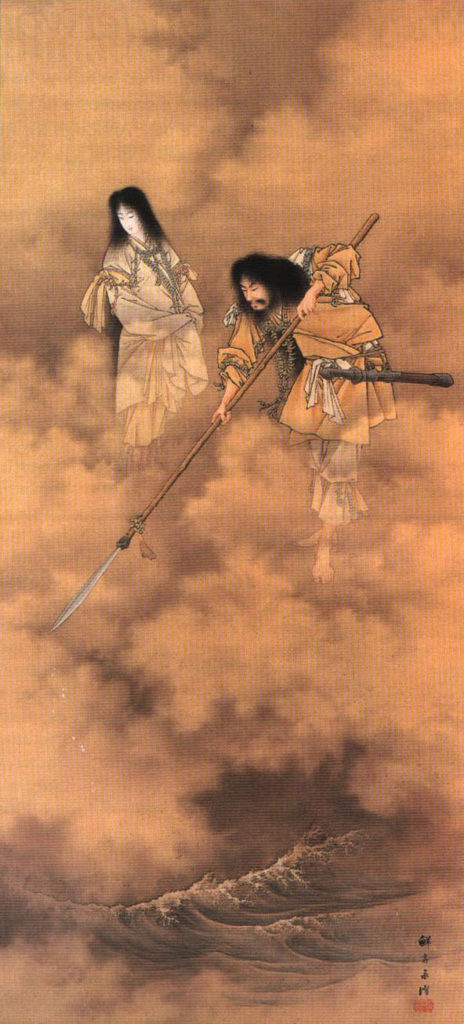
The story of Izanagi and Izanami has been adapted from two traditional sources of Shinto mythology—Nihongi ( “Chronicles of Japan”), translated by W. C Aston, and Ko-ji-ki (“Records or Ancient Matters”), translated by B.H. Chamberlain.
In the very beginning, that is, before the beginning of beginning, Heaven and Earth were one and undivided. Together, they were like an egg, but an egg without limit. The finer matter was diffused and eventually became Heaven, while the coarser matter settled down to become Earth. The finer matter easily came together to give shape to Heaven, but the coarser matter was sluggish and consolidated itself with difficulty. Thus, Heaven was formed before Earth. When Heaven and Earth were divided, the divine beings were produced between them.
Among the divine beings were the seven generations of Gods, of whom the last, the seventh generation, were Izanagi, the Male-Who-Invites, and Izanami, the Female-Who-Invites. When they had come into being, all the other heavenly deities commanded them to give rise to the drifting land. They were given a jewelled spear and, standing upon the Floating Bridge of Heaven, the two deities thrust down the spear and stirred the brine until it curdled. Then they drew up the spear and the brine that dripped down from it formed the Island of Onogoro.
On Onogoro-jima, Izanami and Izanagi built themselves a magnificent palace, with a huge central pillar that reached to heaven. Then the Male-Who-Invites said to his spouse, “How is thy body formed?” The FemaleWho-Invites answered, “My body is completely formed, except that one part is incomplete.” Her spouse replied, “My body too is completely formed, except that one part is superfluous. Let us supplement that which is incomplete in thee with that which is superfluous in me, and thereby create the world.” Izanami replied, “It is well.”
Then Izanagi said, “Let us proceed around the heavenly pillar and, meeting on the other side, let us become united in wedlock. Go thou around the left, and I shall go round from the right.” This they did, and when they met on the other side, Izanami said, “How delightful! I have met a lovely youth!” And Izanagi said, “How delightful! I have met a lovely maiden,” but he thought to himself, “It was inauspicious for the woman to speak first.”
From the union of Izanagi, the Male-Who-Invites, and Izanami, the Female-Who-Invites, came the islands of Japan, the first part of the world to be created. From them also came the gods, including the God of Fire. From that birth, Izanami did not recover, but was mortally burned. She therefore descended into the underworld, and Izanagi was forced to seek her there. In darkness they met, and Izanami begged her husband to be patient and wait at the door of the underworld, and upon no circumstances to bring light into the world of darkness. But Izanagi grew impatient waiting for his wife, and so lit the tooth of his comb. Then, bearing his torch, he entered the palace, seeking Izanami. At last he found her, but to his horror, he beheld her undergoing the process of decomposition. Panic-stricken, he fled, pursued by his wife, and finally emerged into the upper world. Firmly he placed a stone over the aperture to the underworld and recited the chant of separation. Then were they parted forever, Izanagi and Izanami, he to dwell among the gods in heaven, and she to reign in the land of the dead. ♦
From Parabola Volume 3, No. 4, “Androgyny,” Winter 1978. This issue is available to purchase here. If you have enjoyed this piece, consider subscribing.
